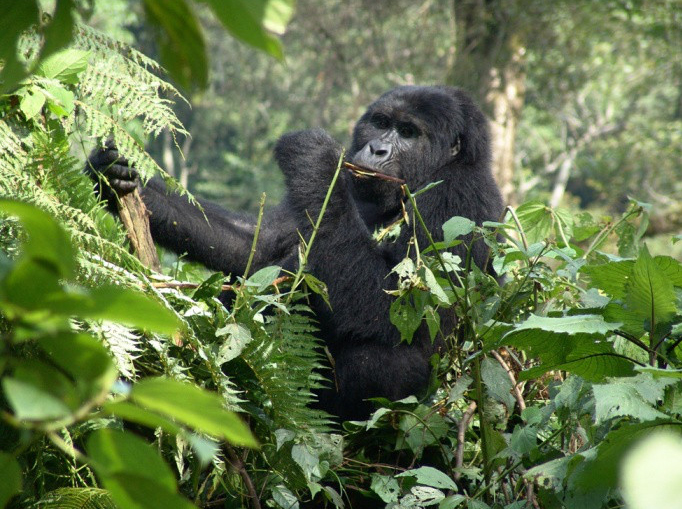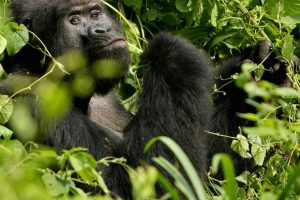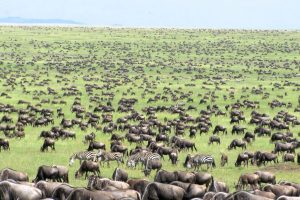Mahale Mountain National Park
The Park is located on the shores of Lake Tanganyika (Africa’s deepest lake) in Kigoma Region and it was named after the Mahale Mountains range that is within its borders.
The park comprises of various unusual characteristics first of which; it is one of the only two protected areas for chimpanzees in the country the other one being Gombe Stream National Park made famous by the researcher Jane Goodall and both Parks are close to each other.
The chimpanzee population in Mahale Mountains National Park is the largest known and due to its size and remoteness, the chimpanzees flourish. It is also the only place where a tourist can find both chimpanzees and lions resided in the same place and are viewable at anytime you visit the Park.
Another unusual feature of the park is that it is one of the very few in Africa that must be experienced by foot. There are no roads or other infrastructure within the park boundaries, and the only way in and out of the park is via boat on the lake.
The Mahale Mountains were traditionally inhabited by the Batongwe and Holoholo people with populations in of 22,000 and 12,500 respectively in 1987.
When the Mahale Mountains Wildlife Research Center was established in 1979 these people were expelled from the mountains to make way for the park which opened in 1985. The people had been highly attuned to the natural environment living with virtually no impact on the ecology.
Mahale covers 1613 square kilometers of rugged rainforest about halfway down the eastern shore of Lake Tanganyika and the Park resides about 700 chimpanzees.
The chimpanzees are therefore reasonably habituated to humans allowing for excellent encounters of which the primates share almost 98.7% of human DNA. Chimpanzee tracking is an interesting experience and it is of a lifetime trekking in the thick forests of the Park.
While tracking, trekkers are advised to maintain maximum silence and once are found, trekkers are not allowed to use flashlight cameras while taking photos because the chimps might fear and then run away while still viewing.
The tracking starts early in the morning though it can also be done during the noon time but trekkers are advised to rush for the morning tracking shift since it is the most appropriate time to view them.
Being so closely related to humans in their biological makeup chimps are susceptible to human ailments including the common cold hence surgical masks are often handed to guest prior to the trekking.
Guests therefore with a cold or those who are carrying communicable ailments aren’t allowed to get close to the chimps since the primates can catch human diseases.
Mahale Mountains is seemingly an impenetrable forest but the routes during the trekking are made easier by the paths that have been carved out for easier access into the forest.
You are likely to pass mango and guava trees that have been growing for 30 years since the time when Japanese scientists fed the chimpanzee fruit as a means of habituating them to the presence of humans. By doing this the scientists were able to study the chimps’ behavior from up close.
The weather too can be unpredictable at times so don’t be surprised if it starts to rain while on the trek and 15 minutes later the sun comes out.
Thus due to the changing weather, trekkers should not forget some heavy clothes on their packing list such as rain coats, sweaters and long sleeved clothes which will give you warmth during the cold hours.
Trekkers should expect to enjoy their chimpanzee tracking in the Park and are advised to view the primates keeping a distance of at least 8 meters from where the chimpanzees are though sometimes this is broken by the chimps themselves when they come close to humans abruptly and unexpectedly since they are famous friends to humans.
There are also several chimpanzee troops in Tanzania’s Mahale Mountains National Park, the majority of these aren’t accustomed to human interaction. Occasionally some of these troops can be observed from boats on Lake Tanganyika although these sightings are brief as the animals immediately disappear into the forest.
Chimp trekking is a fast-growing tourist industry and there are many locations in East and Central Africa where you can encounter chimpanzees but Mahale National Park is arguably the remotest and most picturesque of all the areas. Accommodations within the Park include; Greystoke Mahale camp, Kungwe beach lodge, among others.





